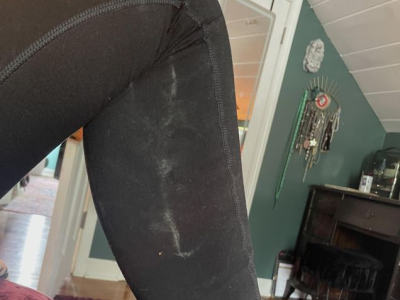Are You Making This Surprising Laundry Mistake That Makes Your Dark Clothes Look Even Dirtier?
By
Gian T
- Replies 0
We’ve all been there: you pull your favourite black pants or navy top out of the washing machine, only to discover they look worse than when you put them in. White streaks, mysterious marks, and a general sense of disappointment—sound familiar? If you’ve ever wondered why your dark clothes come out of the wash looking like they’ve been through a flour fight, you’re not alone!
At the Seniors Discount Club, we know that laundry is one of those never-ending chores, and after decades of experience, you’d think we’d have it down to a fine art. But as it turns out, there’s one sneaky mistake that even the most seasoned laundry veterans can make—and it’s probably the reason your dark clothes are coming out looking less than fresh.
The Case of the Streaky Leggings
Recently, a frustrated woman took to the internet to share her laundry woes. After washing her dark clothes, she found them covered in white marks and streaks. 'Every time I wash my clothes, they look dirtier than before,' she lamented, sharing a photo of her black leggings adorned with stubborn white stains.
She tried everything—separating her colours, using the same detergent as her partner, and even hand-washing after machine washing. Still, the problem persisted. She wondered if it was deodorant build-up from her partner’s shirts or maybe something lurking in the washing machine itself.
The Real Culprit: Too Much Detergent!
The internet’s laundry experts quickly chimed in, and the answer was surprisingly simple: she was using too much laundry detergent. It’s a common mistake, especially with modern high-efficiency washing machines that use less water than older models. When you add too much powder or liquid, the rinse cycle can’t wash it all away, leaving a residue that clings to your clothes—especially dark fabrics.
Let’s be honest—how many of us measure out our detergent? Most of us just eyeball it, thinking a little extra will make things cleaner. But in reality, more detergent doesn’t mean cleaner clothes. In fact, it can do the opposite!
How Much Detergent Do You Really Need?
Some savvy Redditors suggested using even less than the packaging recommends. One person swore by just two tablespoons of detergent per load, while another said they use only one tablespoon and have never had an issue with cleanliness.
If you open your washing machine after a cycle and see suds, that’s a sign you’ve used too much detergent. Not only can this leave your clothes feeling tacky or sticky, but it can also cause a build-up in your machine over time.
Other Common Laundry Mistakes
It’s not just detergent overuse that can cause problems. Here are a few other laundry pitfalls to watch out for:
- Overloading the Machine: Cramming too many clothes into one wash means there’s not enough water or space for everything to rinse properly. This can lead to detergent marks and less effective cleaning.
- Not Cleaning the Washing Machine: Over time, detergent and fabric softener can build up inside your machine, leading to residue on your clothes. Most machines have a cleaning cycle—run it with a washing machine cleaner or a cup of white vinegar every month or so.
- Using Cold Water Incorrectly: While modern detergents are designed to work in cold water, make sure you’re using one that’s formulated for it. Otherwise, a powder may not dissolve properly, leaving streaks behind.
- Pouring Detergent Directly on Clothes: Always add detergent to the dispenser or dilute it in water before adding clothes. Pouring it directly onto fabrics can cause staining and uneven distribution.
How to Fix the Problem
If you’re dealing with detergent residue, don’t worry—it’s an easy fix! Here’s what you can do:
1. Clean Your Washing Machine: Run an empty hot wash with a cup of white vinegar or a washing machine cleaner to clear out any build-up.
2. Use Less Detergent: Start with one tablespoon for a regular load and adjust as needed. Remember, less is more!
3. Wash Smaller Loads: Give your clothes plenty of space to move around and rinse thoroughly.
4. Double Rinse: If you’re still seeing marks, try running an extra rinse cycle to make sure all the detergent is washed away.
Save Money and Your Clothes
Not only will using less detergent keep your dark clothes looking sharp, but it’ll also save you money in the long run. Laundry detergent isn’t cheap, and every extra scoop is money down the drain—literally!
 Have you ever struggled with white marks on your dark clothes? Do you have any tried-and-true laundry tips to share with the community? We’d love to hear your stories and solutions—drop a comment below, and let’s help each other keep our wardrobes looking their best!
Have you ever struggled with white marks on your dark clothes? Do you have any tried-and-true laundry tips to share with the community? We’d love to hear your stories and solutions—drop a comment below, and let’s help each other keep our wardrobes looking their best!
At the Seniors Discount Club, we know that laundry is one of those never-ending chores, and after decades of experience, you’d think we’d have it down to a fine art. But as it turns out, there’s one sneaky mistake that even the most seasoned laundry veterans can make—and it’s probably the reason your dark clothes are coming out looking less than fresh.
The Case of the Streaky Leggings
Recently, a frustrated woman took to the internet to share her laundry woes. After washing her dark clothes, she found them covered in white marks and streaks. 'Every time I wash my clothes, they look dirtier than before,' she lamented, sharing a photo of her black leggings adorned with stubborn white stains.
She tried everything—separating her colours, using the same detergent as her partner, and even hand-washing after machine washing. Still, the problem persisted. She wondered if it was deodorant build-up from her partner’s shirts or maybe something lurking in the washing machine itself.
The Real Culprit: Too Much Detergent!
The internet’s laundry experts quickly chimed in, and the answer was surprisingly simple: she was using too much laundry detergent. It’s a common mistake, especially with modern high-efficiency washing machines that use less water than older models. When you add too much powder or liquid, the rinse cycle can’t wash it all away, leaving a residue that clings to your clothes—especially dark fabrics.
Let’s be honest—how many of us measure out our detergent? Most of us just eyeball it, thinking a little extra will make things cleaner. But in reality, more detergent doesn’t mean cleaner clothes. In fact, it can do the opposite!
How Much Detergent Do You Really Need?
Some savvy Redditors suggested using even less than the packaging recommends. One person swore by just two tablespoons of detergent per load, while another said they use only one tablespoon and have never had an issue with cleanliness.
If you open your washing machine after a cycle and see suds, that’s a sign you’ve used too much detergent. Not only can this leave your clothes feeling tacky or sticky, but it can also cause a build-up in your machine over time.
Other Common Laundry Mistakes
It’s not just detergent overuse that can cause problems. Here are a few other laundry pitfalls to watch out for:
- Overloading the Machine: Cramming too many clothes into one wash means there’s not enough water or space for everything to rinse properly. This can lead to detergent marks and less effective cleaning.
- Not Cleaning the Washing Machine: Over time, detergent and fabric softener can build up inside your machine, leading to residue on your clothes. Most machines have a cleaning cycle—run it with a washing machine cleaner or a cup of white vinegar every month or so.
- Using Cold Water Incorrectly: While modern detergents are designed to work in cold water, make sure you’re using one that’s formulated for it. Otherwise, a powder may not dissolve properly, leaving streaks behind.
- Pouring Detergent Directly on Clothes: Always add detergent to the dispenser or dilute it in water before adding clothes. Pouring it directly onto fabrics can cause staining and uneven distribution.
How to Fix the Problem
If you’re dealing with detergent residue, don’t worry—it’s an easy fix! Here’s what you can do:
1. Clean Your Washing Machine: Run an empty hot wash with a cup of white vinegar or a washing machine cleaner to clear out any build-up.
2. Use Less Detergent: Start with one tablespoon for a regular load and adjust as needed. Remember, less is more!
3. Wash Smaller Loads: Give your clothes plenty of space to move around and rinse thoroughly.
4. Double Rinse: If you’re still seeing marks, try running an extra rinse cycle to make sure all the detergent is washed away.
Save Money and Your Clothes
Not only will using less detergent keep your dark clothes looking sharp, but it’ll also save you money in the long run. Laundry detergent isn’t cheap, and every extra scoop is money down the drain—literally!
Key Takeaways
- Using too much laundry detergent is a common mistake and can leave white streaks and residue on dark clothes.
- Overloading the washing machine and not cleaning it regularly can make detergent build-up worse.
- Many people use far more detergent than necessary; some Redditors recommend using as little as 1–2 tablespoons per wash, even less than what’s suggested on the packaging.
- To prevent detergent stains, measure your detergent carefully, wash smaller loads, and clean your washing machine periodically.








